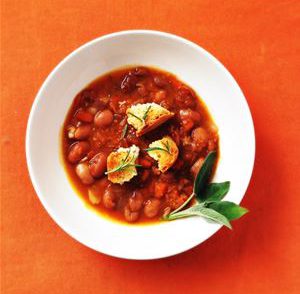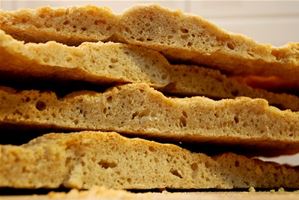Tradition has it that in
Italy old people and children spend time in the mountains during
summer so that they can breathe some healthy fresh air at higher
altitudes. An even older tradition says that animals need this same
treatment.
Come summer, my
valley-dwelling friends in Umbria-one family and their 700
sheep-head to their hill house for fresher, greener pastures and
cooler nights at 1,100 metres. The valley’s heat triggers the
transumanza migration, walking the sheep from the lowlands to the highlands. This
autumn I joined them for the return: the walk down to their winter
abode at the foot of Montefalco. We started before dawn in Pettino,
and more than 25km and one pair of sneakers later, the words ‘slow’
and ‘food’ both had new meaning.
I thought sheep were,
well, just sheep, but these Umbrians wouldn’t dream of putting
their woolly friends (some of whom have names) through the stress of
travelling in trucks! This flock is treated better than many people.
You know the saying
about following like sheep? This flock’s lead sheep is Campanella,
named for the bell around her neck. Trained to follow orders from her
shepherdesses, she enjoys being patted like a dog, something she
expected of me often during our transumanza walk.
We traversed mainly
dirt tracks, old roads and through small, sleepy, hillside villages,
but at one stage we had to take 350 sheep (leaving the pregnant ewes
behind) along a main road and underpass. My friend Giacomo and I, who
both love the countryside but are primarily city dwellers, were
leading the flock when shepherdess Francesca called from behind that
we had missed the left turn and must come around back to it. After a
moment’s astonished, mouth-gaping silence, we discovered that
Italian sheep do not obey stranieri,
are unafraid of people and can push really hard. We gave dignity
away, waving our arms and legs, raising our voices and running back
and forth until they veered left down a steep bank onto the
designated track. I must admit that the dogs helped too, but at that
moment it felt like Giacomo and I were the ones commanding the sheep.
Now in his 70s, Dante used
to walk his sheep from the plains of Umbria all the way to the spot
where Rome’s Fiumicino airport is today, to find fresh grazing
ground. This area, which formed part of the Umbrian Maremma salt
marshes, was great for tasty tufts of salty grass. Dante did this
two-week journey annually for more than 20 years, staying with his
sheep for months at a time. After walking all day with his flock, he
rested at night where there was a grazing field and perhaps a bed. By
way of trade, he made fresh sheep’s milk cheese for the field’s
owners.
Dante and Giuseppina’s
two daughters, my friends Francesca and Maddalena, are part of the
three generations that work together, selling their wonderful organic
pecorino cheese and some sheep and pregnant ewes
(www.umbrianculture.com). The sheep must be shorn, too, but, with the
prevalence of synthetic materials, wool is no longer the profitable
product it was 20 years ago.
Francesca has a
knack for finding local field mushrooms and filling her pockets with
chestnuts while moving the sheep from pasture to pasture. The other
day she made a special dinner with the prizes of her journey:
mushroom and chestnut lasagne. Con questo piatto ho
conquistato mio marito, she tells me proudly. I
believe her, for it is truly divine. I offer it here. Ideally, the
dish is finished by Francesca’s family’s cheese.
Buon appetito!
RECIPE:
Chestnut and field mushroom lasagne
Stage one: Autumn
foraging
You can forage,
filling your pockets with chestnuts from the ground and plucking
field mushrooms. However, mushrooms can be dangerous if you’re not
an expert forager or with one. In that case, buy chestnuts and
finferli (chanterelle) mushrooms from your local
market. Once home, prepare the chestnuts by cutting a slit in each
skin. In a pot, cover the chestnuts with cold water and bring to a
boil with three bay leaves, some rock salt and olive oil. Simmer for
about 30 minutes, until soft, and when still warm, peel off the husk
and blend into a purée with the béchamel sauce, described below.
Stage two: Béchamel
sauce
Prepare a traditional
béchamel sauce: bring to scalding point one litre of whole milk,
together with a small onion studded with cloves. Once it is scalding,
turn off the heat, set aside the onion and let the milk rest. Melt
50g of butter in a heavy-based pot, then mix in 50g of flour, cooking
3-4 minutes to a foam but without colouring the flour. Slowly whisk
in the milk, a little at a time, always bringing back to a boil
before adding more. Once more than half the milk is in the mix, pour
the rest of the milk in. Simmer, stirring constantly, for around 20
minutes, and season to taste. This recipe makes a nice light
béchamel.
Stage three: Adding
flavours
Sautéing the
mushrooms gives them much more flavour and texture than simply
throwing them in. Wipe the mushrooms clean with a damp cloth; never
wash them under running water as you don’t want them moistly stew.
Heat a heavy-based pan with half butter, half oil, throw in a clove
of aglio in camicia (unpeeled garlic clove), and a small
peperoncino (small chilli pepper), then add the chopped
mushrooms, a few at a time. Toss in the oil and butter, adding
seasoning. Set aside and continue until all are cooked.
Stage four:
Assembling the lasagna
Take some fresh
lasagne sheets and run through boiling salted water for a couple of
minutes and begin layering. Begin with a layer of the chestnut
béchamel sauce in the bottom of an oven dish, follow with a layer of
still wet lasagne just out of the boiling water, top with a
sprinkling of the sautéed mushrooms and sliced mozzarella cheese,
and follow again with sauce. Carry on until you have four layers of
the pasta sheets, top with sauce and finish with rough gratings of
the real pecorino (preferrably made by the princess
shepherdesses!)
Stage five: cook
the lasagna
Bake just 20 minutes at
180 degrees celsius allowing a crust to form with the cheese. Leave
to rest 10 minutes out of the oven, cut and serve.
WINE MATCH
Zio Franco’s
homemade wine worked well with this, but even better was the
Perticaia Montefalco Rosso DOC 2007, a wine rich in frutti
di bosco (berry
fruit) aromas that match well with the field mushrooms. The big
fruitiness also offsets the autumn chestnuts well.







